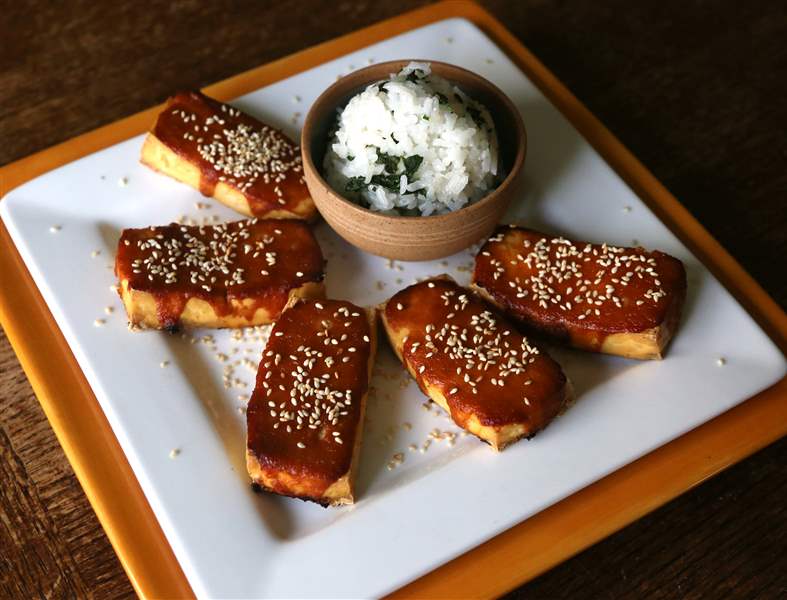
A taste of Toyohashi
8/13/2018
Miso-glazed Tofu with Sticky Rice is a popular dish from Toledo's sister city, Toyohashi, Japan.
The Blade/Kurt Steiss
Buy This Image
Toledo has enjoyed a close relationship with Toyohashi, in southern Japan, for more than 20 years.
While initial contacts were made in 1997, it wasn’t until April 29, 2000, that a formal Sister City designation was signed by then-mayors Masaru Hayakawa and Carty Finkbeiner in Toyohashi. The next month, this was repeated in a ceremony hosted at the Toledo Museum of Art.
Situated with the Mikawa Bay to its west and the Enshu Bay to its south, our sister city shares several similarities with Toledo beyond being a port city. It is noted for its many parks, as well as for museums, gardens, and a zoo. Its climate is temperate with four seasons, though winters aren’t as harsh as they are in Toledo.
Toyohashi’s locale and weather make it particularly well suited to agriculture and farming, with tree fruits, vegetables, and rice among its notable crops.
Kasumi Yamazaki teaches Japanese as a foreign language at the University of Toledo and is the assistant coordinator with the Toyohashi-Toledo Committee which serves as “the bridge between Toledo and Toyohashi,” she said.
Our sister city is “famous for a fish sausage” called chikuwa, said Ms. Yamazaki, which dates to the late Edo period (1603 to 1867). It’s tube-shaped as a result of wrapping the puréed fish around a bamboo rod, usually, before cooking. Gohei-mochi are another regional favorite; these rice cakes are formed onto sticks (reminiscent of ice cream bars), then covered in a sweet sauce before being roasted over a flame.
Toyohashi is also notable for its poultry farming, and is Japan’s top supplier of quail eggs. These are used in many dishes, such as soup, as well as being eaten on their own.
While the city has become noted for Curry Udon — noodles served in a spiced broth — this “is more recent stuff the government decided to promote,” Ms. Yamazaki said. It’s therefore “artificial,” she said.
Although not originally from the city herself, Ms. Yamazaki, who still has family in Japan, attended high school in Toyohashi.
While white miso is ordinarily used in Japanese cuisine, our sister city is “famous for the red miso,” Ms. Yamazaki said. Toyohashi “is the only one” that features this variety in its cooking.
“I grew up drinking red miso instead of white,” she said.
Nameshi Dengaku — red miso-glazed baked tofu served with sticky rice — is therefore a truly representative taste of Toyohashi, Ms. Yamazaki said. “It’s traditional,” but it’s also approachable and easy to make here in Toledo.
This vegan dish, which features rice that is flecked with bits of daikon radish tops, has been served for over 250 years. It’s usually served “with a clear soup with mushroom broth,” Ms. Yamazaki said.
“It has such a long history and it has been celebrated,” she said proudly.

Miso-glazed Tofu with Sticky Rice is a popular dish from Toledo's sister city, Toyohashi, Japan.
Nameshi Dengaku (Miso-glazed Tofu with Sticky Rice)
This dish of miso-glazed baked tofu dates as far back as the 18th century, and was named Dengaku for the dance performed as a prayer in hopes of a good harvest; the recipe has been adapted from Namiko Chen (justonecookbook.com). The complementary Nameshi — sticky rice flecked with bits of daikon radish greens — has been adapted from Makiko Itoh (japantimes.co.jp).
TOFU:
2 14-ounce packages firm tofu
1 tablespoon neutral flavor oil (vegetable, canola, etc.)
2 teaspoons lightly toasted white sesame seeds
MISO SAUCE:
2 tablespoons sake
2 tablespoons mirin
1 tablespoon granulated sugar
4 tablespoons miso (traditionally red miso, but can substitute white; see note)
RICE:
1½ cups sticky white rice
1⅔ cups water
The tops from 2 daikon radishes
1 teaspoon salt
Prepare the tofu: Wrap the tofu with 2 sheets of paper towel and press the tofu between two plates, with a weight on top, for 30 minutes.
Preheat the oven to 400F.
Once the tofu is dehydrated, cut it into ¾-inch wide strips.
Place the tofu on a rimmed baking sheet lined with parchment paper or a silicone baking sheet. With a brush, apply vegetable oil on top and bottom of tofu. Bake for 30 minutes.
Combine the sauce ingredients in a small saucepan. Mix well to combine and then bring to gentle simmer over the lowest heat. Stir constantly and cook for 2 to 3 minutes, making sure the miso doesn’t burn. When the miso has thickened, it’s ready to use.
Adjust a rack 6 inches from the heat element and preheat broiler for 3 minutes. Meanwhile carefully spoon some of the miso sauce onto your tofu and spread evenly. Broil for 3 to 4 minutes, or until the top has a nice char and caramelization. Sprinkle with sesame seeds.
Prepare the rice: While the tofu bakes, cook the rice according to package directions (ideally in a rice cooker).
Rinse the daikon leaves in several changes of water.
Bring a pan of water to a boil and cook the leaves for 1½ to 2 minutes, depending on how thick the stems are. Drain, and cool rapidly under cold running water. Squeeze out the leaves and sprinkle with the salt. Squeeze the leaves out again to remove any excess water as you rub in the salt. Chop the leaves roughly, then stir them into the hot rice.
Serve the tofu alongside the rice. Kasumi Yamazaki, who works with the Toledo Sister Cities International, says that it is also served “typically with some pickles and soup.”
Note: Red miso is available at Lai Lai Market, 3205 Central Ave.
Yield: 4 servings
Contact Mary Bilyeu at 419-724-6155 or mbilyeu@theblade.com, and follow her at facebook.com/thebladefoodpage.